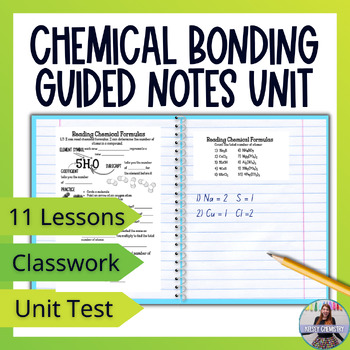Chemical Bonding & Nomenclature Unit Guided Notes with Worksheets and Test
Kelsey Chemistry
504 Followers
Grade Levels
9th - 12th
Subjects
Resource Type
Standards
NGSSHS-PS1-2
Formats Included
- Zip
Pages
11 days guided notes & slides, 3 versions unit test, 4 vocabulary resources + matching quiz, 11 quic
Kelsey Chemistry
504 Followers
What educators are saying
This is my first year to teach Chemistry and the videos not only help me understand it but helps me be a better teacher. The notes are great, the videos and google slides are on point. The activities and checkpoints are good too!! All around great curriculum.
This resource is excellent for teaching bonding, naming, etc. My students were able to learn and retain the information with the notes and practice questions. This is also helping me, a former chemistry hater, to actually enjoy teaching!
Products in this Bundle (12)
showing 1-5 of 12 products
Bonus
Unit Plan & Full Unit Slide Decks
Also included in
- A full year chemistry curriculum that contains 98 guided notes lessons for your students with 4 final exams to finish your school year. This bundle is growing and will soon include vocabulary activities and quizzes, and unit tests for every unit. Download the preview file to get a look and the breakPrice $335.00Original Price $482.50Save $147.50
Description
My collection of chemical bonding lessons. Beginning with ionic bonding, students learn how chemical bonds are formed. After chemical nomenclature, comes covalent bonding, VSEPR Theory and Metallic Bonding.
Lessons Included:
- Ionic Bonding
- Reading Chemical Formulas
- Criss Cross Rule
- Transition Metals
- Polyatomic Ions
- Naming Ionic Compounds
- Covalent Bonding
- Lewis Structures
- Naming Covalent Compounds
- VSEPR Theory (Valence Shell Electron Pair Repulsion Theory)
- Metallic Bonding
WHO IS IT FOR?
This lesson is perfect for a first year high school chemistry class, or physical science class.
WHAT'S INCLUDED?
- 12 Slide Decks (x3 verisons: Whimsical, Classical and Dark Mode)
- A 15-ish minute lesson with guided notes in 2 styles: full page or half page (for interactive notebooks)
- Links to Copy Google Slides
- Show What You Know Questions designed for Self Assessment for each lesson
- 11 quick practice worksheets, 1 per lesson for a short classwork assignment
- 5 Vocabulary resources: a list of terms, 1 set of flash cards, a joke decipher puzzle, a crossword, Term-Definition Dominoes and 3 versions of a matching quiz
- 11 lesson plans in the 5Es style
- Full All Star Planning Style Unit Plan
- List of learning targets and vocab terms to act as a student study guide
- 1 Midpoint quiz on Ionic Bonding
- 3 versions of a 35 question unit test: 12 T/F style questions, 13 MC questions and 10 written nomenclature questions
FEATURES
- Guided notes that have students listening to you instead of writing notes.
- Accurate diagrams, so students don't have to rely on their art skills to learn.
- Self assessment questions to ensure students are understanding content and know they may need to ask for help
NOT SURE WHERE THIS FITS IN YOUR SCHOOL YEAR?
Check out my free chemistry curriculum outline for my suggestions!
ALSO INCLUDED IN:
This product by Kelsey Reavy is copyrighted for single classroom only. This product may not be resold and can be copied for personal use within a classroom only. If you have questions, please email kelsey@kelseyreavy.com © Kelsey Reavy
Total Pages
11 days guided notes & slides, 3 versions unit test, 4 vocabulary resources + matching quiz, 11 quic
Answer Key
Included
Teaching Duration
3 Weeks
Report this resource to TPT
Reported resources will be reviewed by our team. Report this resource to let us know if this resource violates TPT’s content guidelines.
Standards
to see state-specific standards (only available in the US).
NGSSHS-PS1-2
Construct and revise an explanation for the outcome of a simple chemical reaction based on the outermost electron states of atoms, trends in the periodic table, and knowledge of the patterns of chemical properties. Examples of chemical reactions could include the reaction of sodium and chlorine, of carbon and oxygen, or of carbon and hydrogen. Assessment is limited to chemical reactions involving main group elements and combustion reactions.






